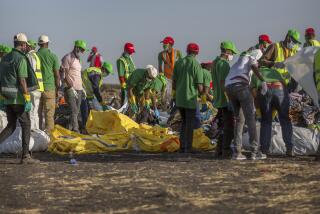The better tanker didn’t win
- Share via
Retired Air Force Gen. Charles Horner, who recently penned the Blowback “ Boeing’s tanker tantrum,” had an outstanding career in service to our country. Boeing’s employees, who provide our soldiers, sailors and airmen with the products and services they need to carry out their missions, salute him and all our men and women in the military. That is why, after his distinguished career, it is all the more mystifying why Horner would dispense so much misinformation about the U.S. Air Force aerial refueling tanker competition while carrying out his duty to his employers at Northrop Grumman.
First and foremost, in upholding Boeing’s protest of the tanker contract award to the team of Northrop and EADS, the Europe-based parent of Airbus, the Government Accountability Office found that if serious flaws had not occurred in the evaluation of proposals, the Boeing KC-767 Advanced Tanker could very well have been selected. Using the Air Force’s stated requirements for evaluating the proposals, the Boeing plane was the more capable aircraft at the best value for the taxpayer. In fact, as the GAO found, the KC-767 was the only awardable solution as defined by the Air Force requirements. It met three times as many requirements as the Northrop-EADS plane and more of the higher-priority requirements defined by the Air Force.
Horner’s assertion that the GAO decision supported only a few minor issues out of more than 100 is a myth. The Boeing protest was focused on 15 key issues; the GAO supported or recommended that the Air Force reevaluate 10. Industry analysts and others familiar with defense acquisitions called the GAO’s critique a rare and serious condemnation of a process in which significant flaws appear to have had an influence on the decision.
Horner wrongly suggests that Boeing is telling the Air Force what it needs for its new tanker. On the contrary, Boeing chose to custom-fit the KC-767 for the requirements and missions defined by the Air Force. Meanwhile, Northrop boldly threatened to walk away from the competition unless the Air Force changed the requirements, including the originally realistic mission scenarios, to fit its team’s oversized KC-30. But that is in the past. Looking ahead, the Northrop-EADS team has defiantly said that it will offer the exact same Airbus A330-based plane in the upcoming competition -- even before the Pentagon issues a new Request for Proposals outlining its requirements. Boeing has always held the position that the Air Force’s requirements would determine our offering, not the other way around.
Even as Americans agonize over the soaring cost of gas, Horner minimizes the importance of fuel savings over the life of these aircraft. The KC-767 would save billions over the Airbus plane. Whether the savings add up to $30 billion or $40 billion depends on the price of oil. The more efficient KC-767 would save 1,000 to 2,000 gallons of fuel on almost every mission -- tens of thousands of missions each year, year after year. All of these savings are possible while still carrying out the needed mission.
Finally, the KC-30 has yet to transfer fuel -- the primary mission of an aerial refueling tanker. It has not been proven, tested or delivered to any customer as a certified tanker. In fact, the first KC-30 is still not even fully built. Boeing is the only company that has delivered more than 2,000 tankers and has been involved in the mission for the past 75 years. So which company has the lower risk, dedicated workforce, proven facilities and tools to make the next Air Force tanker? With all due respect to Horner, the answer is, without a doubt, Boeing.
Dan Beck is director of external communications for Boeing Integrated Defense Systems.
Blowback is an online forum for full-length responses to our articles, editorials and Op-Eds. Click here to read more about Blowback, or submit your own by e-mailing us at opinionla@latimes.com.
More to Read
A cure for the common opinion
Get thought-provoking perspectives with our weekly newsletter.
You may occasionally receive promotional content from the Los Angeles Times.









